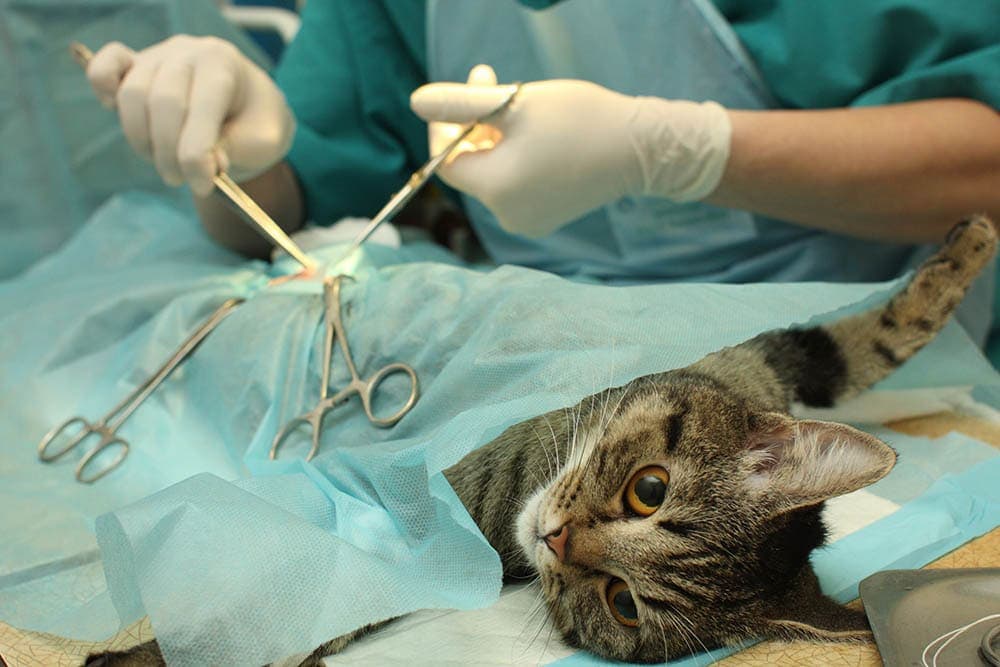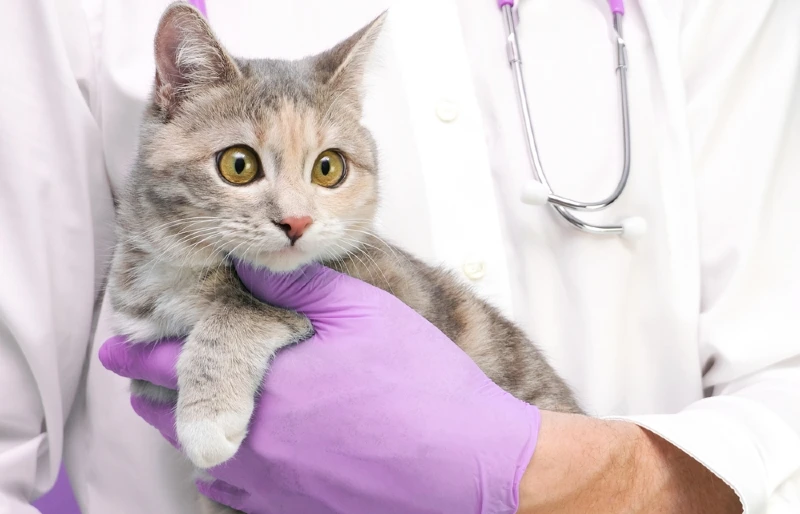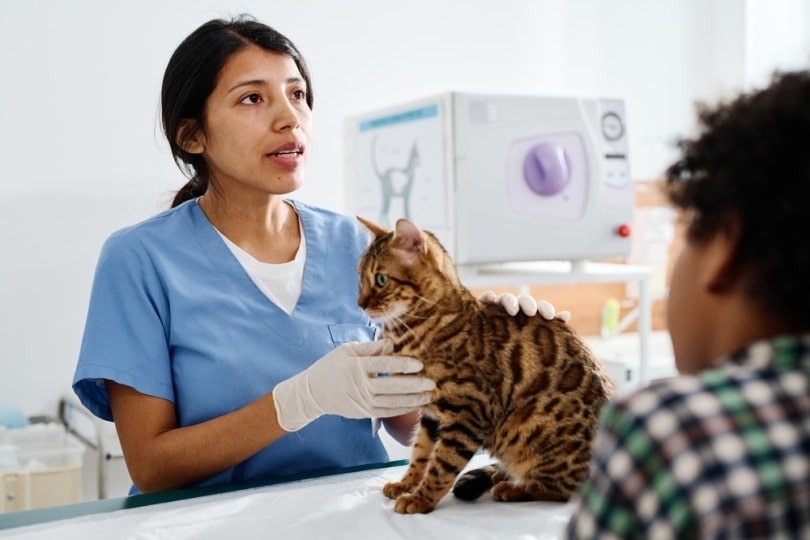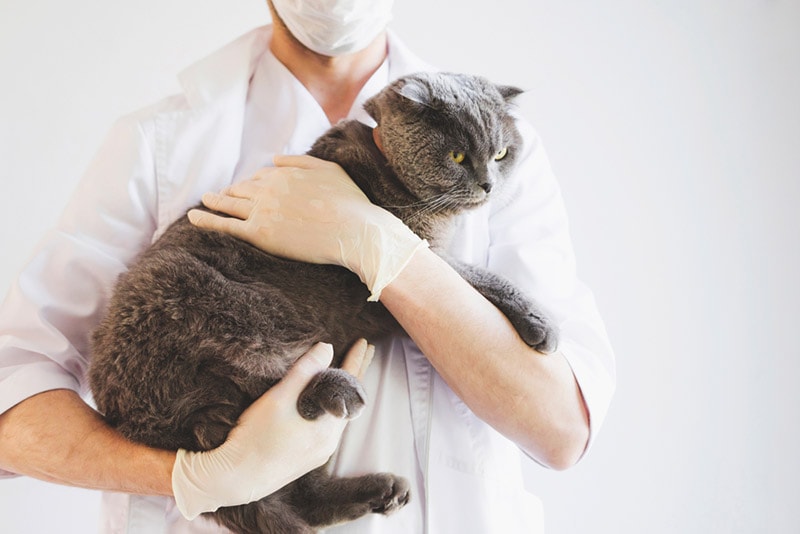How Long Do Cats Take to Recover From Spaying? (Vet Answer)
By Dr. Leigh Wilder, DVM (Vet)
Updated on

A spay is a surgical procedure that you may consider for your pet to prevent unintended pregnancy in your female cat or kitten. While the procedure is common and routine, surgery for your feline friend may have you feeling anxious—what does the procedure entail, and how long will it take for your cat to recover?
The good news is that most cats will be feeling back to their normal selves within a day or two after surgery and can return to their normal routine within 10–14 days of the procedure. Below, we’ll discuss spaying in further detail, including its timing, benefits, recovery, and risks of this important surgical procedure, to provide you with the information necessary to make the best decision for the health of your cat.
What Is a Spay Procedure?
A spay most commonly refers to an ovariohysterectomy (OHE), which is the surgical sterilization of a pet via removal of the ovaries, fallopian tubes, and uterus. An OHE is an abdominal surgery performed under general anesthesia, so your cat will be “asleep” while the procedure is underway. Once an OHE has been performed, your cat will no longer be able to reproduce, and will no longer experience heat cycles or the behaviors associated with cycling. While an OHE is the sterilization procedure most commonly performed in the United States, surgical alternatives such as ovariectomy (removal of the ovaries only) and hysterectomy (removal of the uterus and part of the fallopian tubes) exist and may be considered for your cat. A discussion with your veterinarian can help you determine which surgical procedure may be most appropriate for your pet.
Why Should I Have My Cat Spayed?
- Decreased risk of mammary carcinoma, a common type of cancer seen in intact female cats. By spaying your cat before either 6 or 12 months of age, you can expect a 91% or 86% reduction, respectively, in their risk of developing mammary carcinoma compared to an intact cat.
- Elimination of reproductive emergencies, including pyometra, a life-threatening uterine infection.
- Prevention of unplanned litters, which may result from pregnancy in cats as young as 4 months of age.
- A potential decrease in behavioral problems. Intact female cats experience behavior changes when entering their estrus cycle, which may be difficult to live with for many owners. Increased vocalization and affection, urine marking, and the attraction of unneutered male cats may all be noted.
When Should I Have My Cat Spayed?
According to the Veterinary Task Force on Feline Sterilization, cats should be spayed by 5 months of age. This recommendation is based on the known benefits of spaying and the lack of adverse effects related to spaying kittens at a young age. Wide support for this evidence-based recommendation is present, and it has been endorsed by the American Veterinary Medical Association (AVMA), the American Association of Feline Practitioners (AAFP), the American Animal Hospital Association (AAHA), and the Association of Shelter Veterinarians, among other groups.
Spaying and neutering is an important part of pet care, but it's not the only health expense your pet is likely to incur. A personalized pet insurance plan from a company like Lemonade can help you manage costs and care for your pet at the same time.

What Can I Expect on the Day of My Cat’s Surgery?
The most important thing you can do to ensure that the day of your pet’s procedure goes smoothly is to follow the specific instructions provided by your veterinarian. On the morning of your cat’s surgery, you may be asked to withhold food. This is recommended because general anesthesia may cause nausea and vomiting in some animals, which can be dangerous for a sedated pet.
Once your pet has arrived at the veterinary clinic, it will receive a physical examination by the veterinarian to ensure that they appear healthy enough to undergo surgery. Pre-anesthetic blood work may also be recommended to help identify any conditions (such as kidney or liver disease), which may put your cat at a higher risk for complications from general anesthesia. Once your cat or kitten has been cleared for surgery, you can generally expect the procedure to take approximately 20 minutes. Your pet will be monitored by veterinary staff throughout their surgery and after they wake up, and they will likely be able to return home the evening of their procedure.
How Do I Care For My Cat During Recovery?
For the first 24 hours after surgery, your cat may seem a bit “off” compared to how they usually behave. This is common and expected as your feline is recovering from major abdominal surgery. Your veterinarian may recommend offering a small meal on the evening of their procedure, as your cat may feel nauseated after their procedure. It may also be recommended to keep them in a small or confined area—such as a bathroom or laundry room—where you can easily monitor them during this immediate postoperative period. Grogginess, a temporary decrease in appetite, increased vocalization, or irritation may all be noted and can be a normal part of recovery after general anesthesia.
- Pale or white gums
- Depressed attitude, unable to stand or walk
- Difficulty breathing
- Continuous bleeding from their incision or an incision that appears open
- Multiple episodes of vomiting
- Straining to urinate, or lack of urination within 12–24 hours after surgery
Within a day or two of surgery, your cat or kitten will likely seem back to their normal selves! At this point, it may be tempting to let them return to their normal activities.
- Elizabethan collar: Your veterinarian will likely recommend that your cat wear an Elizabethan collar (also known as a cone or E-collar). This is important as it will prevent your cat from licking at their surgical incision, a behavior that can lead to infection of the incision.
- Incision care: Monitor your pet’s incision daily, and make sure to keep the area clean and dry at all times. Mild swelling of the incision can be normal and should improve over time. Significant swelling, redness, discharge from the incision, or an incision that appears to be opening up all require further evaluation by your veterinarian.
- Medication administration: Your veterinarian will send your feline home with pain medication following their spay procedure; it is important to give the medication according to the directions. Over-the-counter pain medications such as aspirin are toxic to cats, and should never be administered without the recommendation of your veterinarian.
- Decreased activity level: Running, jumping, and vigorous playing are not recommended during your pet’s recovery period. These activities may impede the healing of their incision, and could potentially lead to issues with the incision requiring additional veterinary treatment. If you are having difficulty managing your cat’s activity level, keeping them in a smaller, confined area as mentioned above for the duration of their recovery may be appropriate.
Most veterinarians will recommend a check-up after 10–14 days to ensure that your pet’s incision has healed appropriately and that there have been no post-operative concerns. If your cat has any skin stitches from their surgery these will also be removed at this time. Once your veterinarian has evaluated your cat and given the go-ahead, they should be able to fully return to their normal routine!

What Are Potential Complications From a Spay Procedure?
Feline spay procedures are very routine and are among the most common surgical procedures performed by veterinarians. Like any surgical procedure, however, there is a potential risk for complications related to either general anesthesia or the surgery itself. The most commonly noted surgical complications associated with spay procedures include bleeding, incisional swelling, pain, and incisional dehiscence (opening of the incision). Thankfully, the risk of complications following sterilization surgery in felines is very low.
Will My Cat’s Personality Change After Spaying?
While your cat’s pleasant personality will not be affected by having her spayed, behavior changes associated with the lack of hormones present following surgery may be noted. The increased vocalization, affection, and restlessness previously associated with your cat’s heat cycle should disappear after she has recovered from her procedure.
One important change to note following your cat’s spay procedure is that once sterilized, she will be at a higher risk of becoming overweight. Providing ample opportunities for exercise and play on a daily basis will help ensure that your frisky feline maintains an appropriate weight. Additionally, discussing your cat’s diet and eating habits with your veterinarian can help ensure that they are on the right track when it comes to staying fit.
Final Thoughts
In conclusion, spaying your female cat is an important decision with the ability to positively affect their health long-term. Following your veterinarian’s post-operative instructions and contacting them with any questions or concerns is essential and will go a long way to ensuring a smooth recovery for your feline friend.
Featured Image Credit: De Visu, Shutterstock














